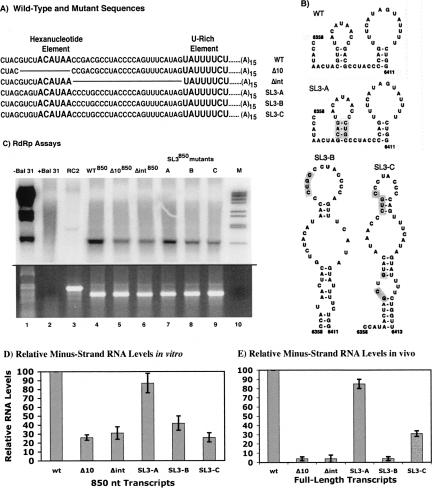FIGURE 3.
Effects of mutations in the hexanucleotide region on minus-strand RNA synthesis. (A) Sequences extending from just upstream of the hexanucleotide element and through the U-rich element of the PVX 3′ NTR are shown for wild-type and mutant templates. The regions of sequence deleted in mutants Δ10 and Δint are indicated by lines within the sequence. Site-directed mutations in SL3 (SL3A, SL3B, SL3C) are indicated by text that is underlined. (B) Corresponding predicted structures for wild-type and SL3 mutants (Pillai-Nair et al. 2003) are illustrated, with shading of altered sequences. (C) Products obtained in RdRp assays with 850-nt templates corresponding to the wild-type and mutant sequences. Lane 1 contains products from endogenous templates in the untreated RdRp extracts. Lane 2 represents a control for nuclease Bal 31 treatment, indicating that endogenous templates have been removed and no specific products are obtained. Lane 10 contains the double-stranded DNA marker described in Figure 2. Lanes 3–9 include products obtained when wild-type and mutant templates were added to nuclease Bal 31 treated extracts. (D) Quantification of the RdRp assay data. (E) Data obtained with corresponding mutant and wild-type full-length transcripts in protoplasts (Pillai-Nair et al. 2003). Error bars are as described in the Figure 2 legend.

